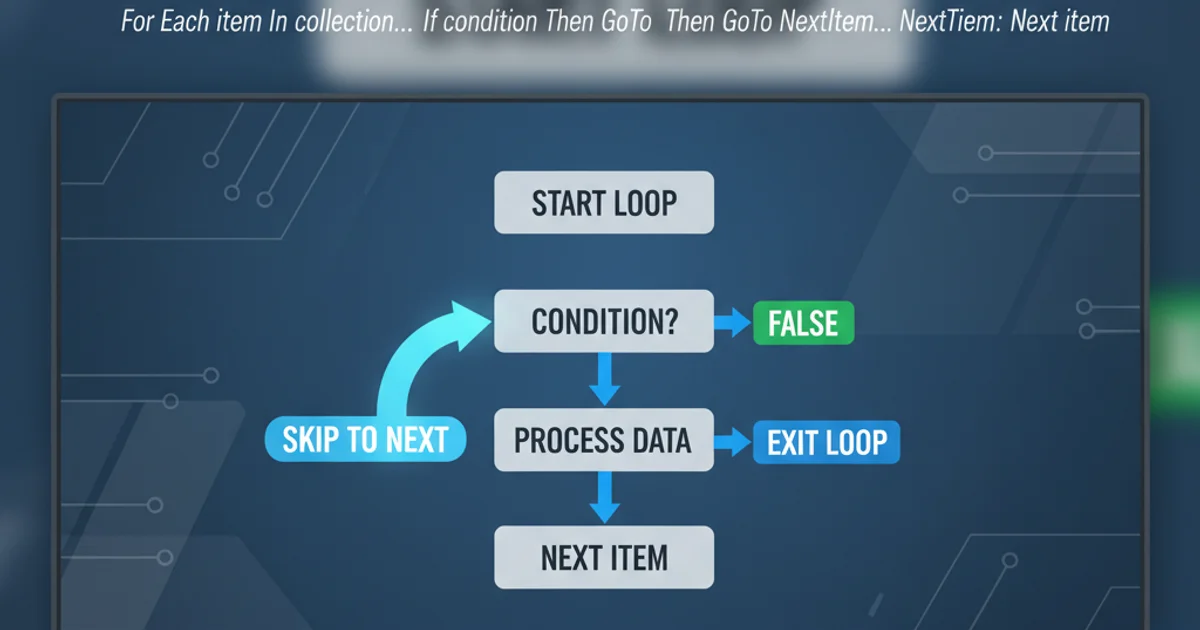Skip to next iteration in loop vba
Categories:
Mastering Loop Control: Skipping to the Next Iteration in VBA

Learn how to efficiently control the flow of your VBA loops by skipping to the next iteration using Continue For, Continue Do, and GoTo statements, optimizing your code for specific conditions.
In VBA programming, loops are fundamental for automating repetitive tasks. However, there are often scenarios where you need to bypass certain iterations based on specific conditions, rather than exiting the entire loop. This article explores various methods to achieve this, focusing on Continue For, Continue Do, and the more general GoTo statement, providing practical examples and best practices.
Understanding Loop Control Statements
VBA offers several constructs to manage loop execution. While Exit For and Exit Do terminate a loop entirely, sometimes you only need to skip the remainder of the current iteration and proceed to the next one. This is crucial for maintaining loop integrity while handling exceptions or specific data points.
flowchart TD
A[Start Loop] --> B{Condition Met?}
B -- Yes --> C[Skip to Next Iteration]
C --> A
B -- No --> D[Execute Current Iteration Code]
D --> A
A -- Loop Ends --> E[End Loop]Conceptual flow of skipping to the next iteration in a loop.
Using Continue For for For...Next Loops
The Continue For statement is the most direct and recommended way to skip to the next iteration within a For...Next loop. When VBA encounters Continue For, it immediately stops executing the current iteration's code and proceeds to the next value in the loop's counter.
Sub SkipEvenNumbers()
Dim i As Integer
For i = 1 To 10
If i Mod 2 = 0 Then
' If i is even, skip to the next iteration
Debug.Print "Skipping even number: " & i
Continue For
End If
' This code only executes for odd numbers
Debug.Print "Processing odd number: " & i
Next i
End Sub
Example of using Continue For to process only odd numbers.
Continue For over GoTo for For...Next loops as it improves code readability and maintainability by clearly indicating intent.Using Continue Do for Do...Loop Structures
Similar to Continue For, the Continue Do statement is designed for Do...Loop structures (both Do While...Loop and Do Until...Loop). It allows you to bypass the remaining code in the current iteration and jump directly to the next evaluation of the loop condition.
Sub ProcessPositiveNumbers()
Dim num As Integer
Dim counter As Integer
counter = 0
Do While counter < 5
num = Int((Rnd * 20) - 10) ' Generate random number between -10 and 9
If num <= 0 Then
' If number is not positive, skip to the next iteration
Debug.Print "Skipping non-positive number: " & num
Continue Do
End If
' This code only executes for positive numbers
Debug.Print "Processing positive number: " & num
counter = counter + 1
Loop
End Sub
Example of using Continue Do to process only positive random numbers.
Using GoTo for General Loop Skipping (Less Recommended)
While Continue For and Continue Do are specific to their loop types, the GoTo statement can be used in any loop structure to jump to a specified label. To skip to the next iteration, you would place a label immediately before the Next or Loop keyword. However, excessive use of GoTo can lead to 'spaghetti code' which is difficult to read and debug.
Sub GoToSkipExample()
Dim i As Integer
For i = 1 To 5
If i = 3 Then
Debug.Print "Using GoTo to skip iteration " & i
GoTo NextIteration
End If
Debug.Print "Processing item " & i
NextIteration:
Next i
End Sub
Using GoTo to skip an iteration in a For...Next loop.
GoTo for loop control if Continue For or Continue Do are available. GoTo can make code harder to follow and maintain. Reserve GoTo for error handling or very specific, well-justified scenarios.Best Practices for Loop Control
Effective loop control is key to writing robust and efficient VBA code. Here are some best practices:
1. Use Specific Continue Statements
Always prioritize Continue For for For...Next loops and Continue Do for Do...Loop structures. They are designed for this purpose and make your code more readable.
2. Keep Conditions Clear
Ensure the conditions that trigger a skip are clear and concise. Complex conditions should be broken down or encapsulated in helper functions for better understanding.
3. Avoid Nested GoTo Jumps
If you must use GoTo, ensure it's a simple, forward jump within the same scope. Avoid jumping into or out of nested loops or complex conditional blocks, as this can lead to unpredictable behavior.
4. Comment Your Code
When using any loop control statement, especially GoTo, add comments explaining why a particular iteration is being skipped. This helps future developers (and your future self) understand the logic.